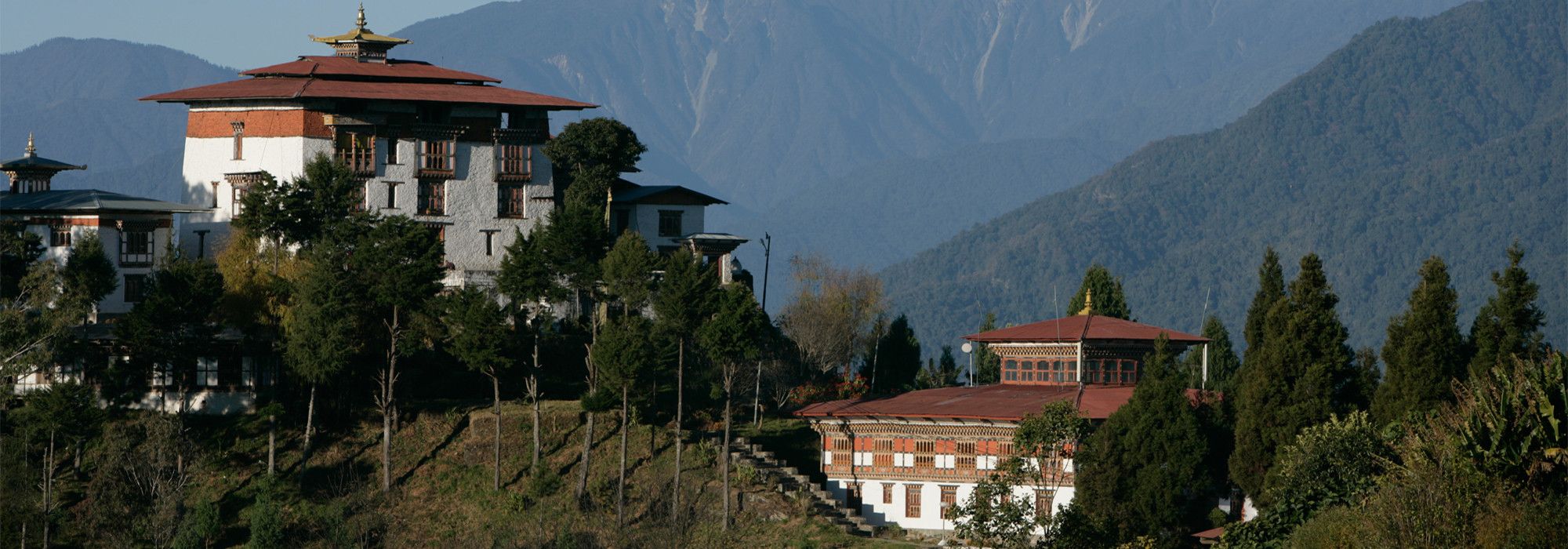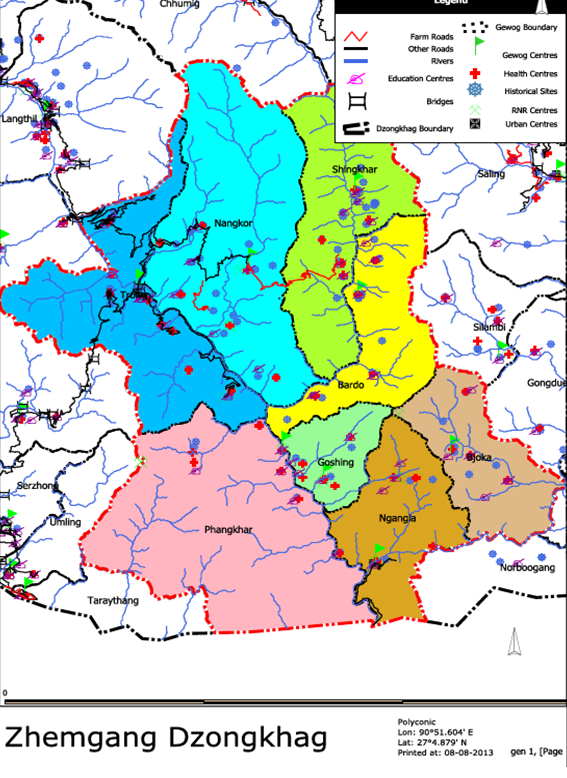Vision
Towards a dynamic and efficient local government for socio-economic development, cultural diversity and ecological integrity to mainstream GNH in the Dzongkhag
Mission
- To ensure sustainable socio-economic development
- To provide efficient and effective public service delivery
- To uphold transparency, accountability and integrity
Objectives
- To enhance food and nutrition security
- To strengthen and enhance local economy
- To enhance effectiveness and efficiency of public service delivery
- To promote good governance and improve public service delivery
- To provide effective and efficient direction and operational services
 Zhemgang Dzongkhag lies in the South-central region of the country sharing its borders with Bumthang to the north, Trongsa and Sarpang to the west, Mongar and Pemagatshel to the east and the Indian State of Assam in the South. The Dzongkhag is a part of the wildlife corridor constituting the famous Royal Manas National Park, the Jigme Singye Wangchuck National Park, and Phrumshingla National Park. The Dzongkhag is administratively supported by a Drungkhag in Panbang, and eight Gewogs namely Bjoka, Bardo, Goshing, Nangkor, Nangla, Phangkhar, Shingkhar and Trong. Zhemgang is considered as one of the most inaccessible Dzongkhags in the country. Its population is 17,763 (Male: 9,195 Female: 8,568) with a total Gung of 3803.
Zhemgang Dzongkhag lies in the South-central region of the country sharing its borders with Bumthang to the north, Trongsa and Sarpang to the west, Mongar and Pemagatshel to the east and the Indian State of Assam in the South. The Dzongkhag is a part of the wildlife corridor constituting the famous Royal Manas National Park, the Jigme Singye Wangchuck National Park, and Phrumshingla National Park. The Dzongkhag is administratively supported by a Drungkhag in Panbang, and eight Gewogs namely Bjoka, Bardo, Goshing, Nangkor, Nangla, Phangkhar, Shingkhar and Trong. Zhemgang is considered as one of the most inaccessible Dzongkhags in the country. Its population is 17,763 (Male: 9,195 Female: 8,568) with a total Gung of 3803.
The people of the dzongkhag cultivate mainly maize followed by rice, buckwheat, millet, barley, wheat, foxtail millet, potato, etc. Oranges are the main source of cash income for the southern and central Gewogs of the Dzongkhag. The northern Gewogs depend mainly on livestock products for source of income.
The Dzongkhag is popularly known by the name Khengrig-Nam-Sum, which means the Dzongkhag is divided into three agro-ecological zones-Upper Kheng covering Bardo and Shingkhar with high altitude areas, Middle Kheng covering Nangkhor and Trong with middle altitude areas and Lower Kheng covering Phangkhar, Goshing, Nangla and Bjoka with mid-low altitude areas.
Zhemgang is a region blessed with incredibly rich biodiversity. Its lush forests are home to 22 endangered animal species including the Golden Langur. Though much of the district has warm and humid climatic conditions, its northern regions have moderately cool temperatures.
Zhemgang is notable for being one of the last regions where ancient Bon (Animist) religious practices are still carried out. Though Buddhism has been growing in popularity, every region of the district still continues its animist traditions and Bon priests known as Bonpo are considered respected religious leaders. The inhabitants of Zhemgang are famous for their rich culture, particularly their folk songs and dances. They are also famed for their skill at crafting various goods out of bamboo such as Bangchungs (matted bamboo bowls), Palangs (alcohol containers), Balaks (hats), mats and boxes. They are also adept potters and their earthenware products were highly prized throughout the country in the past.
There are also a number of famous Buddhist temples in the region such as Buli Lhakhang and Tharpa Choeling Lhakhang. These ancient temples were built by Terton Pema Lingpa, a famous revealer of the lost religious treasures of Guru Rimpoche.
One of the most interesting features in Zhemgang is the Royal Manas National Park. This protected park is the oldest nature preserve in the Kingdom of Bhutan. Its incredible biodiversity includes hundreds of rare animal and plant species such as Golden Langurs and the Asian One-horned Rhinoceros that cannot be seen anywhere else in the world. The park is the most biologically diverse protected area in the kingdom as well as one of the most outstanding nature preserves worldwide.
Lama Zhang Dorje Drakpa who lived in the 12th century founded the Zhemgang dzong. Lama Zhang Dorje Drakpa, a renowned scholar-sage of Drukpa kgyu school of Buddhism, originated from Tibet and travel to present Zhemgang in 1163. Lama Zhang set up a hermitage in on the present site of the Dzong and settled there for many years. In 1655 CE, a one-storied Dzong was built on the hermitage to defend the land against invaders led by Choestse Penlop.Khenrig Namsung is the ancient name of Zhemgang Dzongkag. It literally means the three divisions of Kheng: Upper (Chikhor), Middle (Namkor), and Lower (Tamachok) Kheng.
Dzongkhag is also supported by important institutions and regional offices;
RDTC ( Rural Development Training Centre)
RLDC ( Rural Livelihood Development Centre)
RMBF ( Regional Mithun Breeding Farm)
BPC ( Bhutan Power Corporation)
RICBL ( Royal Insurance Corporation Of Bhutan Limited)
BDBL (Bhutan Development Bank Limited)
RSTA ( Road Safety and Transportation Authority)
ZFD ( Zhemgang Forest Division)
BOD ( Bhutan Oil Distributor)
